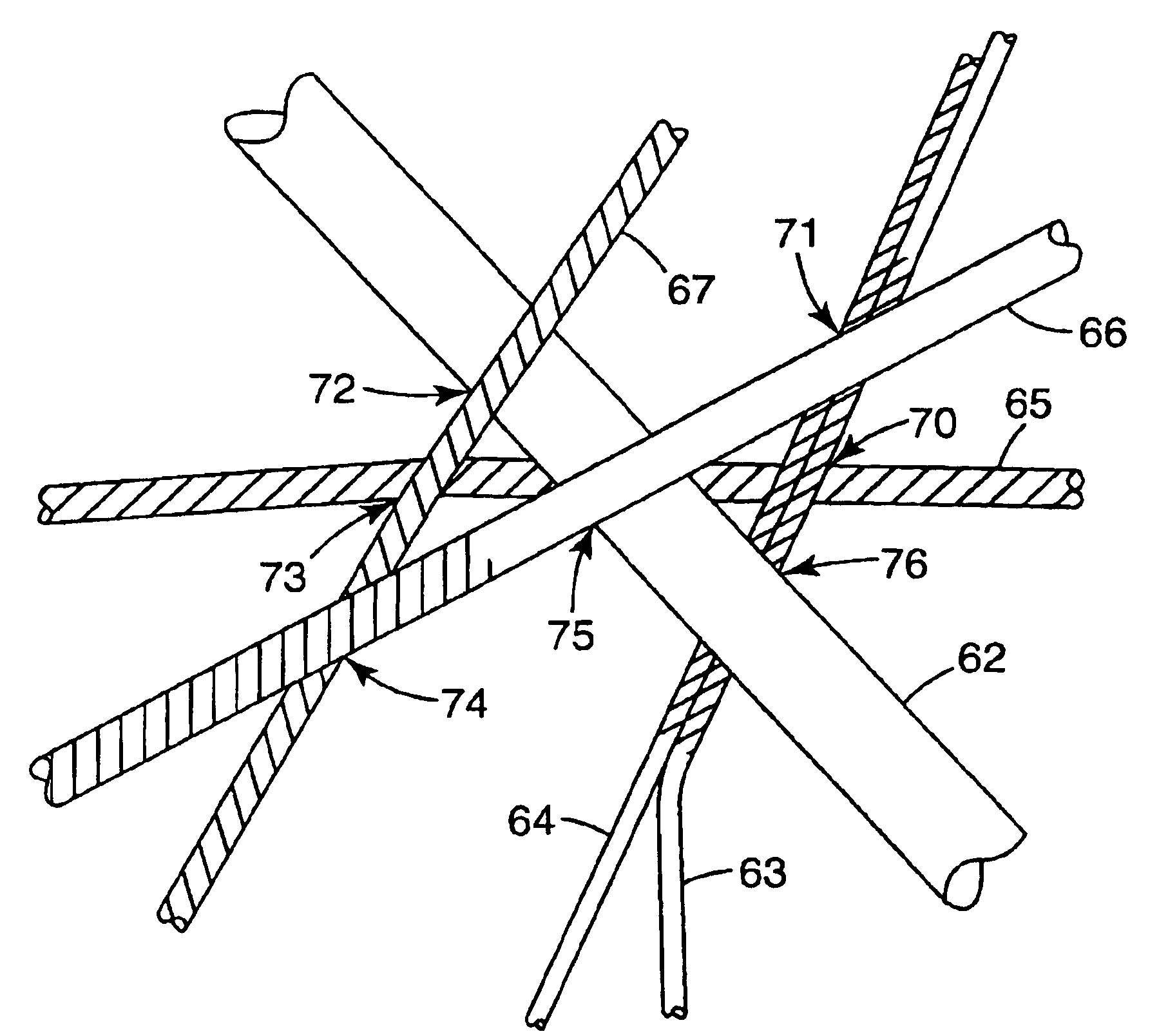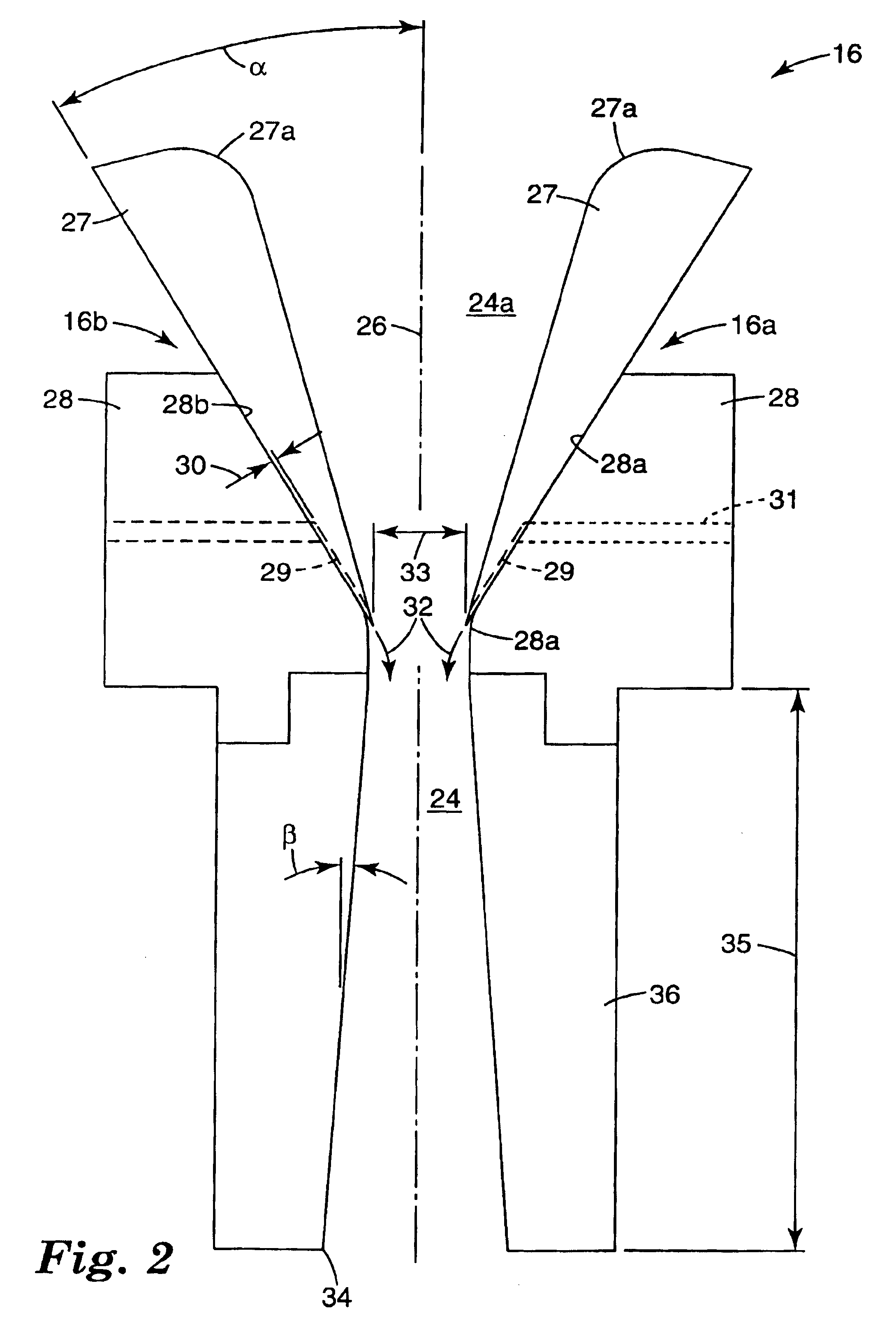Bondable, oriented, nonwoven fibrous webs and methods for making them
a technology of nonwoven fibrous webs and fibers, applied in the field of bonded nonwoven webs, can solve the problems of increasing the cost of the web, requiring undesirable compromises in processing steps or product features, and fibers with limited capacity to participate in fiber bonding, and achieves the effect of convenient bondability
- Summary
- Abstract
- Description
- Claims
- Application Information
AI Technical Summary
Benefits of technology
Problems solved by technology
Method used
Image
Examples
examples 1-4
[0078]Apparatus as shown in FIGS. 1-3 was used to prepare four different fibrous webs from polyethylene terephthalate having an intrinsic viscosity of 0.60 (3M PET resin 651000). In each of the four examples PET was heated to 270° C. in the extruder (temperature measured in the extruder 12 near the exit to the pump 13), and the die was heated to a temperature as listed in Table 1 below. The extrusion head or die had four rows of orifices, and each row had 21 orifices, making a total of 84 orifices. The die had a transverse length of 4 inches (101.6 millimeters). The hole diameter was 0.035 inch (0.889 mm) and the L / D ratio was 6.25. The polymer flow rate was 1.6 g / hole / minute.
[0079]The distance between the die and attenuator (dimension 17 in FIG. 1) was 15 inches (about 38 centimeters), and the distance from the attenuator to the collector (dimension 21 in FIG. 1) was 25 inches (slightly less than 64 centimeters). The air knife gap (the dimension 30 in FIG. 2) was 0.030 inch (0.762 ...
examples 5-8
[0087]Fibrous webs were prepared on apparatus as shown in FIGS. 1-3 from polybutyl terephthalate (PBT-1 supplied by Ticona; density of 1.31 g / cc, melting point 227° C., and glass transition temperature 66° C.). The extruder temperature was set at 245° C. and the die temperature was 240° C. The polymer flow rate was 1 gram per hole per minute. The distance between the die and attenuator was 14 inches (about 36 centimeters), and the attenuator to collector distance was 16 (about 41 centimeters). Further conditions are stated in Table 4 and other parameters were generally as given for Examples 1-4.
[0088]
TABLE 4ExampleAttenuator GapAttenuator GapAttenuator AirNo.Top (mm)Bottom (mm)Flow (ACMM)56.834.342.8364.574.374.5974.573.914.0587.755.542.86
[0089]The webs were collected in an unbonded condition and then passed through an oven at 220° C. for one minute. FIG. 8 is an SEM at 500× showing bonds in a web of Example 5.
[0090]Birefringence was studied, with a range and average birefringence f...
examples 9-14
[0091]Webs of polytrimethylene terephthalate (PTT) fibers were prepared on apparatus as shown in FIGS. 1-3 using (in Examples 9-11) a clear version of the PTT (CP509201 supplied by Shell Chemicals) and (in Examples 12-14) a version that contained 0.4% TiO2 (CP509211). The extrusion die was as described in Examples 1-4 and was heated to a temperature as listed in Table 5 below. The polymer flow rate was 1.0 g / hole / minute.
[0092]
TABLE 5Die / ExtruderAttenuatorAttenuatorAttenuatorExampleTemperatureGap TopGap BottomAir FlowNo.(° C.)(mm)(mm)(ACMM)92603.863.201.73102653.863.202.49112653.683.024.81122653.282.823.82132653.282.824.50142604.503.781.95
[0093]The distance between the die and attenuator (dimension 17 in FIG. 2) was 15 inches (about 38 centimeters), and the distance from the attenuator to the collector (dimension 21 in FIG. 2) was 26 inches (about 66 centimeters). Other parameters were as given in Examples 1-4 or as described in Table 5. Webs were collected in an unbonded condition o...
PUM
| Property | Measurement | Unit |
|---|---|---|
| angle | aaaaa | aaaaa |
| diameter | aaaaa | aaaaa |
| angle | aaaaa | aaaaa |
Abstract
Description
Claims
Application Information
 Login to View More
Login to View More - R&D
- Intellectual Property
- Life Sciences
- Materials
- Tech Scout
- Unparalleled Data Quality
- Higher Quality Content
- 60% Fewer Hallucinations
Browse by: Latest US Patents, China's latest patents, Technical Efficacy Thesaurus, Application Domain, Technology Topic, Popular Technical Reports.
© 2025 PatSnap. All rights reserved.Legal|Privacy policy|Modern Slavery Act Transparency Statement|Sitemap|About US| Contact US: help@patsnap.com



